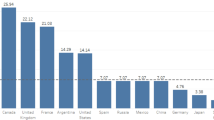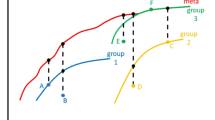Abstract
Applications of non-parametric frontier production methods such as Data Envelopment Analysis (DEA) have gained popularity and recognition in scientometrics. DEA seems to be a useful method to assess the efficiency of research units in different fields and disciplines. However, DEA results give only a synthetic measurement that does not expose the multiple relationships between scientific production variables by discipline. Although some papers mention the need for studies by discipline, they do not show how to take those differences into account in the analysis. Some studies tend to homogenize the behaviour of different practice communities. In this paper we propose a framework to make inferences about DEA efficiencies, recognizing the underlying relationships between production variables and efficiency by discipline, using Bayesian Network (BN) analysis. Two different DEA extensions are applied to calculate the efficiency of research groups: one called CCRO and the other Cross Efficiency (CE). A BN model is proposed as a method to analyze the results obtained from DEA. BNs allow us to recognize peculiarities of each discipline in terms of scientific production and the efficiency frontier. Besides, BNs provide the possibility for a manager to propose what-if scenarios based on the relations found.







Similar content being viewed by others
Notes
Retrieved February 2009, from http://industrial.udea.edu.co/jgvillegas/Pagina%20DEA/index.html.
Retrieved February 2009, from http://www.hugin.com/.
Retrieved July 2008, from http://thirina.colciencias.gov.co:8081/scienti/jsp/grupos.jsp.
References
Bonaccorsi, A., & Daraio, C. (2004). Econometric approaches to the analysis of productivity of R&D systems. Production functions and production frontiers. In W. Glänzel, U. Schmoch, M. Zitt, E. Bassecoulard, & M. Luwel (Eds.), Handbook of quantitative science and technology research (pp. 51–74). Amsterdam, Netherlands: Springer.
Bonaccorsi, A., Daraio, C., & Simar, L. (2006). Advanced indicators of productivity of universities. An application of robust nonparametric methods to Italian data. Scientometrics, 66(2), 389–410.
Charnes, A., Cooper, W. W., & Rhodes, E. (1978). Measuring the efficiency of decision-making units. European Journal of Operational Research, 2(6), 429–444.
Cherchye, L., & Vanden Abeele, P. (2005). Onresearch efficiency: A microanalysis of Dutch university research in economic and business management. Research Policy, 34, 495–516.
Cooper, W. W., Seiford, L. M., & Zhu, J. (2004). In J. Zhu, W. W. Cooper, R. D. Banker, & L. M. Seiford (Eds.), Handbook on data envelopment analysis (pp. 1–39). Boston: Kluwer Academic.
Doyle, J., & Green, R. (1994). Efficiency and cross-efficiency in DEA: Derivations, meanings and uses. The Journal of the Operational Research Society, 45(5), 567–578.
Garg, K. C., Gupta, B. M., Jamal, T., Roy, S., & Kumar, S. (2005). Assessment of impact of AICTE funding on R&D and educational development. Scientometrics, 65(2), 151–160.
Guan, J. C., & Wang, J. X. (2004). Evaluation and interpretation of knowledge production efficiency. Scientometrics, 59(1), 131–155.
Heckerman, D. (1999). A tutorial on learning with Bayesian networks. In M. Jordan (Ed.), Learning in graphical models. Cambridge, MA: MIT Press.
Kim, H., & Park, Y. (2008). The impact of R&D collaboration on innovative performance in Korea: A Bayesian network approach. Scientometrics, 75(3), 535–554.
Kjaerulff, U. B., & Madsen, A. L. (2008). Bayesian networks and influence diagrams. A guide to construction and analysis. New York: Springer.
Korhonen, P., Tainio, R., & Wallenius, J. (2001). Value efficiency analysis of academic research. European Journal of Operational Research, 130(1), 121–132.
Lamirel, J. C., Al Shehabi, S., Francois, C., & Polanco, X. (2004). Using a compound approach based on elaborated neural network for Webometrics: An example issued from the EICSTES project. Scientometrics, 61(3), 427–441.
Lehmann, S., Jackson, A. D., & Lautrup, B. E. (2008). A quantitative analysis of indicators of scientific performance. Scientometrics, 76(2), 369–390.
Leydesdorff, L. (1992). Knowledge representations, Bayesian inferences, and empirical science studies. Social Science Information, 31(2), 213–237.
Meng, W., Hu, Z., & Liu, W. (2006). Efficiency evaluation of basic research in China. Scientometrics, 69(1), 85–101.
Pearl, J. (Ed.). (2000). Causality: Models, reasoning, and inference (pp. 1–40). Cambridge: Cambridge University Press.
Restrepo, M., & Villegas, J. (2007). Clasificación de grupos de investigación colombianos aplicando análisis envolvente de datos. Revista Facultad de Ingeniería Universidad de Antioquia, 42, 105–119.
Rousseau, S., & Rousseau, R. (1997). Data envelopment analysis as a tool for constructing scientometric indicators. Scientometrics, 40(1), 45–56.
Rousseau, S., & Rousseau, R. (1998). The scientific wealth of European nations: Taking effectiveness into account. Scientometrics, 42(1), 75–87.
Sexton, T. R., Slinkman, R. H., & Hogan, A. (1986). Data envelopment analysis: Critique and extensions. In R. H. Silkman (Ed.), Measuring efficiency: An assessment of Data Envelopment Analysis (Vol. 32, pp. 73–105). San Francisco: Jossey-Bass.
Spirtes, P., Glymour, C. N., & Scheines, R. (2000). Discovery algorithms for causally sufficient structures. In P. Spirtes, C. N. Glymour, & R. Scheines (Eds.), Causation, prediction, and search (pp. 73–122). Cambridge, MA: MIT Press.
Author information
Authors and Affiliations
Corresponding author
Rights and permissions
About this article
Cite this article
Ruiz, C.F., Bonilla, R., Chavarro, D. et al. Efficiency measurement of research groups using Data Envelopment Analysis and Bayesian networks. Scientometrics 83, 711–721 (2010). https://doi.org/10.1007/s11192-009-0122-y
Received:
Published:
Issue Date:
DOI: https://doi.org/10.1007/s11192-009-0122-y




